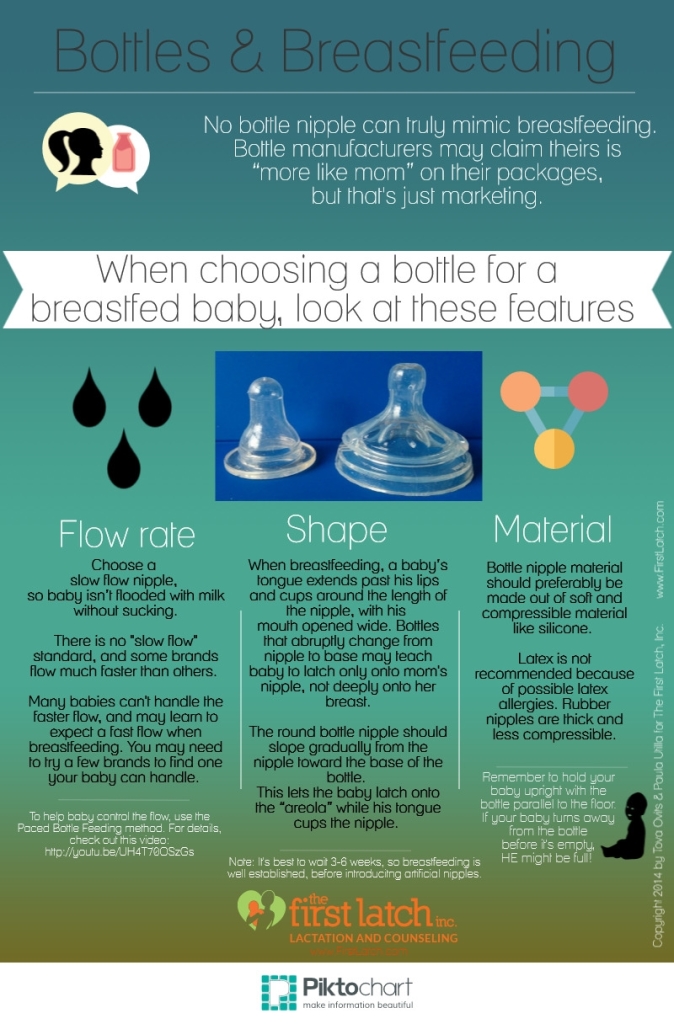Bottles & Breastfeeding
Please click here for full-size printable image.
Many moms wonder how their baby will be fed when they’re apart, regardless of whether they are separated for a quick trip to the gym or for a full day at their jobs. Using a cup to feed mom’s expressed milk can be an option, even for a young baby. However, many caregivers are more accustomed to using bottles. Note: It’s best to wait at least 3-6 weeks before introducing a bottle, to make sure breastfeeding is well established.
You might have heard the term “nipple confusion,” where bottle-fed babies seem like they’re refusing to breastfeed. But babies are smart, not confused! With bottles, many babies learn to expect a fast, steady flow without the sucking that breastfeeding requires.
To help avoid this expectation of steady flow, use Paced Bottle Feeding if your baby drinks from a bottle. Paced Bottle Feeding allows the baby to control the flow of milk, and the amount he drinks. Tilting a bottle into a reclining baby’s mouth can force him to swallow or choke, and force him to drink more than he wants. When feeding a baby with a bottle, hold the baby upright, with the bottle parallel to floor, so he sucks when he’s ready for more milk. If he turns his head, remove the bottle; he might be done!
Researchers are studying the link between bottle feeding and obesity. They think that the caregiver’s pressure to finish all the milk in the bottle can turn off the baby’s fullness cues, so even as an adult he doesn’t recognize when his stomach is full!
Most like mom?
No bottle nipple can truly mimic breastfeeding at mom’s breast. Bottle manufacturers may claim that their bottles or nipples are “more like mom” on their packages, but that’s just marketing. Every baby is different, so you might need to try a few styles to find one your baby can accept. Here are a few features to look for when choosing a bottle for a breastfed baby.
Flow rate
When breastfeeding, a baby has to suck to trigger mom’s let-down reflex and suck to transfer the milk from breast to his mouth. Breastmilk doesn’t flow at a steady pace, so in addition to using the paced bottle feeding method, choose a slow-flow nipple to avoid flooding the baby with milk. A slower flow also gives the baby time to realize that his stomach is full.
Unfortunately, there is no industry standard for calling a nipple “slow flow,” and some brands labeled that way flow MUCH faster than others. For example, Dr. Brown’s Narrow slow flow nipple has one of the slowest flows; the Medela Calma flows almost 4 times faster in studies!
Shape
When breastfeeding, a baby opens his mouth wide and extends his tongue past his lip. His tongue cups around the length of mom’s nipple and onto her areola. A bottle nipple should be round and slope gradually from the tip to the base. This gradually widening shape allows baby’s tongue to extend and cup the nipple as his lips latch onto the “areola” — the base of the bottle nipple.
Bottles that abruptly transition from the long nipple to the base can teach a baby to latch only onto mom’s nipple! (Ow!) An orthodontic nipple teaches baby to pull his tongue back in his mouth, instead of extend it for a good latch. If your nipple looks “orthodontic” after baby breastfeeds, PLEASE call us or your local breastfeeding supporters for help!
Material
When breastfeeding, your nipple stretches in baby’s mouth as he sucks. Choose a bottle nipple made of soft, compressible material like silicone.
Latex nipples are not recommended because of possible latex allergies. Rubber nipples are thick and less compressible than silicone.
Breastfeed when together
Breastfeeding often when together will help your baby and your milk production. It’ll also help you, as the more feeds he receives at your breast, the less milk you’ll need to pump for the time you’re apart! Most babies drink about 25-30 ounces of breastmilk over 24 hours from months 1-6.
Have you combined breastfeeding and bottle feeding?
